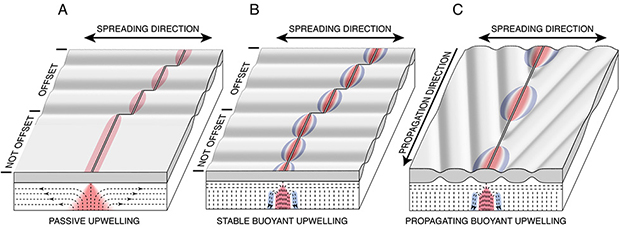
Propagating Rift Hypothesis
Earth's Fastest Spreading Ridge
Hawaii Institute of Geophysics and Planetology
Crustal segmentation and mantle upwelling

Crustal segmentation and mantle upwelling. Colored ovals depict the surface projection of mantle upwelling cells with red indicating upward advection and blue downward flow. Frontal facades depict a vertical section with dashed lines indicating mantle flow in colored areas and frozen-in fabric in blank areas. Along the ridge axis (fine double line) the upwelling cells produce thicker crust near their centers and thinner crust near their ends as depicted in the crustal layer (gray). (A) Plate-driven or passive mantle upwelling produces crustal segmentation only at ridge axis offsets and can only generate horizontal flow fabric and horizontal seismic anisotropy on ridge flanks unlike the pronounced vertical anisotropy observed on the Reykjanes Ridge flanks. (B) Spatially stable buoyant mantle upwelling cells (colored ovals) produce crustal segmentation whether or not the ridge segments are offset by transform faults (thin solid lines). (C) On a linear axis underlain by gradients in mantle properties, as near Iceland, buoyant upwelling cells can propagate systematically along axis producing crustal V-shaped ridges and troughs whose geometry is a function of the propagation rate of the instability and spreading rate.
Return to the “Active Reorganization of North Atlantic Seafloor Spreading” page.

